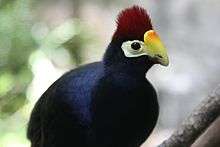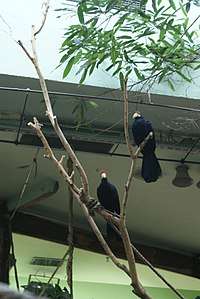Ross's turaco
| Ross's turaco | |
|---|---|
 | |
| Scientific classification | |
| Kingdom: | Animalia |
| Phylum: | Chordata |
| Class: | Aves |
| Order: | Musophagiformes |
| Family: | Musophagidae |
| Genus: | Musophaga |
| Species: | M. rossae |
| Binomial name | |
| Musophaga rossae Gould, 1852 | |
 | |
Ross's turaco or Lady Ross's turaco (Musophaga rossae) is a mainly bluish-purple African bird of the turaco family, Musophagidae. They are sometimes referred to as Go-Away birds due to their distinctive calls - ("g-way").[2]
Characteristics
This species expresses very little sexual dimorphism, with both males and females being the same deep shade of blue with red head crowns and flight feathers. Females can have slightly more yellow-green beaks while males always have a bright yellow, with both having a forehead shield that flares to a medium orange. Their wings are round and short, best for short bursts of powered flight. They have black legs with three forward facing toes; with a fourth toe being semi-zygodactylous, which makes them nimble canopy dwellers. Size can very from 15 to 18 inches and weigh just under one pound. They are considered very sturdy birds that can live anywhere from 8 to 20 years. Sources on life spans tend to very. [3][4][5]

Habitat
This bird is mostly found in woodlands, open forest and riparian habitats in Angola, Botswana, Burundi, Cameroon, Central African Republic, Democratic Republic of the Congo, Gabon, Kenya, Rwanda, South Sudan, Tanzania, Uganda, and Zambia. They generally avoid heavily forested areas and their numbers remain strong despite the threat of habitat destruction due to agriculture expansion. These birds are non-migrating and rarely travel far from their birth place, but will travel if food is not abundant in their immediate area.[6]
Diet
These birds are largely frugivorous, consuming mostly the fruits, flowers, and seeds of both wild and cultivated plants. They are known for being one of the biggest seed spreaders in the region. They will also eat small insects like termites and snails; especially around brooding season. Their genus name (Musophagidae) actually means “plantain eater” which is a misnomer, because they rarely gravitate to banana or plantain trees. They actually prefer figs over most things. Due to their opportunistic feeding style, they are considered pests in most areas because they can easily destroy crops and gardens.
Reproduction

Ross's turaco form monogamous breeding pairs that share incubation and feeding duties. They lay 2 to 3 eggs which hatch after roughly 25 days. They then spend another 4 to 7 weeks nesting with their parents before they fledge. Strangely, they become mostly independent before they can fly, opting to climb about in the canopy of the forest. They reach sexual maturity after one year of age and remain near their parents in extended family flocks of up to thirty individuals. Flock members often assist in raising other flock members chicks, especially when the female is a first time mother.[7] These birds are known to become more territorial around brooding season, especially with predatory or unfamiliar birds.
Captivity
It is quite common in captivity, although not as common as its nearest relative the violet turaco. Zoo diets often consist of "oranges, apples, mangoes, pears, papayas, bananas, and soft bill diet pellets." [8] These birds do quite well in captivity as they prefer to climb over flight, and breed quite readily with extended lives compared to their wild counterparts. They are kept as pets, but are largely found in zoos and botanical gardens due to their colors and easy nature.[9][10]
References
- ↑ BirdLife International (2012). "Musophaga rossae". IUCN Red List of Threatened Species. Version 2013.2. International Union for Conservation of Nature. Retrieved 26 November 2013.
- ↑ "Lady Ross". cincinnatizoo.org. Retrieved 2 July 2017.
- ↑ "Minnesota Zoo". Retrieved 1 July 2017.
- ↑ "Lady Ross’s Turaco" (PDF). Cincinnati Zoo. Retrieved 30 June 2017.
- ↑ "Lady Ross's Turaco Birds". Sea World. Retrieved 1 July 2017.
- ↑ "Musophaga rossae". iucnredlist. Retrieved 2 July 2017.
- ↑ "TuracoLadyRoss" (PDF). sfzoodocents. Retrieved 2 July 2017.
- ↑ "Lady Ross’s Turaco" (PDF). Cincinnati Zoo. Retrieved 30 June 2017.
- ↑ "Ross's Turaco". Retrieved 2 July 2017.
- ↑ "Turacos". DAVIS LUND AVIARIES. Retrieved 2 July 2017.
External links
 Media related to Musophaga rossae at Wikimedia Commons
Media related to Musophaga rossae at Wikimedia Commons
